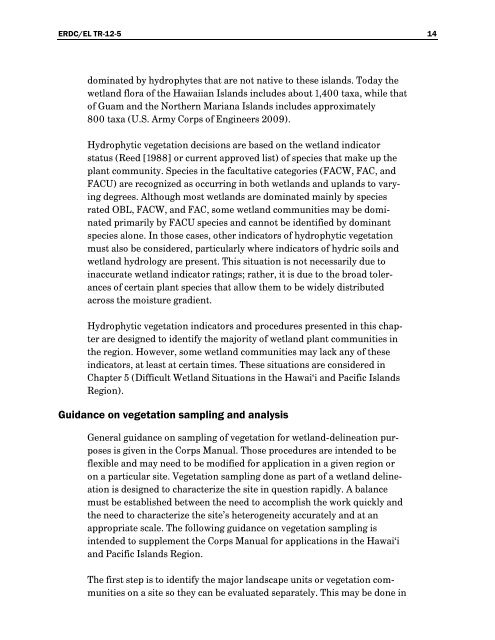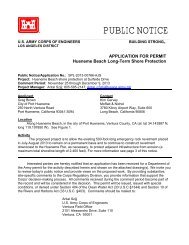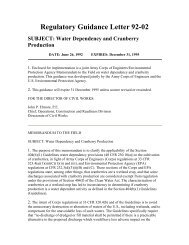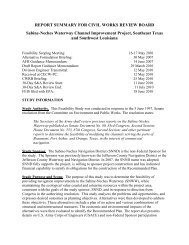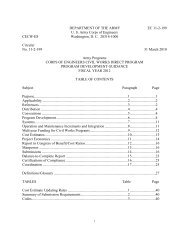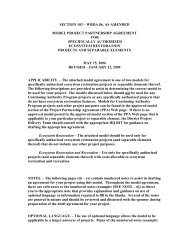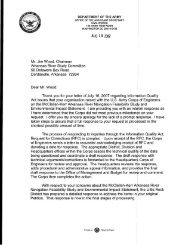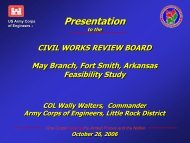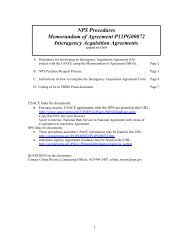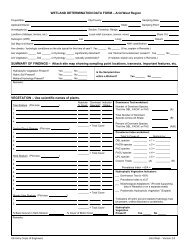Hawaii and the Pacific Islands - U.S. Army Corps of Engineers
Hawaii and the Pacific Islands - U.S. Army Corps of Engineers
Hawaii and the Pacific Islands - U.S. Army Corps of Engineers
Create successful ePaper yourself
Turn your PDF publications into a flip-book with our unique Google optimized e-Paper software.
ERDC/EL TR-12-5 14dominated by hydrophytes that are not native to <strong>the</strong>se isl<strong>and</strong>s. Today <strong>the</strong>wetl<strong>and</strong> flora <strong>of</strong> <strong>the</strong> <strong>Hawaii</strong>an Isl<strong>and</strong>s includes about 1,400 taxa, while that<strong>of</strong> Guam <strong>and</strong> <strong>the</strong> Nor<strong>the</strong>rn Mariana Isl<strong>and</strong>s includes approximately800 taxa (U.S. <strong>Army</strong> <strong>Corps</strong> <strong>of</strong> <strong>Engineers</strong> 2009).Hydrophytic vegetation decisions are based on <strong>the</strong> wetl<strong>and</strong> indicatorstatus (Reed [1988] or current approved list) <strong>of</strong> species that make up <strong>the</strong>plant community. Species in <strong>the</strong> facultative categories (FACW, FAC, <strong>and</strong>FACU) are recognized as occurring in both wetl<strong>and</strong>s <strong>and</strong> upl<strong>and</strong>s to varyingdegrees. Although most wetl<strong>and</strong>s are dominated mainly by speciesrated OBL, FACW, <strong>and</strong> FAC, some wetl<strong>and</strong> communities may be dominatedprimarily by FACU species <strong>and</strong> cannot be identified by dominantspecies alone. In those cases, o<strong>the</strong>r indicators <strong>of</strong> hydrophytic vegetationmust also be considered, particularly where indicators <strong>of</strong> hydric soils <strong>and</strong>wetl<strong>and</strong> hydrology are present. This situation is not necessarily due toinaccurate wetl<strong>and</strong> indicator ratings; ra<strong>the</strong>r, it is due to <strong>the</strong> broad tolerances<strong>of</strong> certain plant species that allow <strong>the</strong>m to be widely distributedacross <strong>the</strong> moisture gradient.Hydrophytic vegetation indicators <strong>and</strong> procedures presented in this chapterare designed to identify <strong>the</strong> majority <strong>of</strong> wetl<strong>and</strong> plant communities in<strong>the</strong> region. However, some wetl<strong>and</strong> communities may lack any <strong>of</strong> <strong>the</strong>seindicators, at least at certain times. These situations are considered inChapter 5 (Difficult Wetl<strong>and</strong> Situations in <strong>the</strong> Hawai‘i <strong>and</strong> <strong>Pacific</strong> Isl<strong>and</strong>sRegion).Guidance on vegetation sampling <strong>and</strong> analysisGeneral guidance on sampling <strong>of</strong> vegetation for wetl<strong>and</strong>-delineation purposesis given in <strong>the</strong> <strong>Corps</strong> Manual. Those procedures are intended to beflexible <strong>and</strong> may need to be modified for application in a given region oron a particular site. Vegetation sampling done as part <strong>of</strong> a wetl<strong>and</strong> delineationis designed to characterize <strong>the</strong> site in question rapidly. A balancemust be established between <strong>the</strong> need to accomplish <strong>the</strong> work quickly <strong>and</strong><strong>the</strong> need to characterize <strong>the</strong> site’s heterogeneity accurately <strong>and</strong> at anappropriate scale. The following guidance on vegetation sampling isintended to supplement <strong>the</strong> <strong>Corps</strong> Manual for applications in <strong>the</strong> Hawai‘i<strong>and</strong> <strong>Pacific</strong> Isl<strong>and</strong>s Region.The first step is to identify <strong>the</strong> major l<strong>and</strong>scape units or vegetation communitieson a site so <strong>the</strong>y can be evaluated separately. This may be done in


